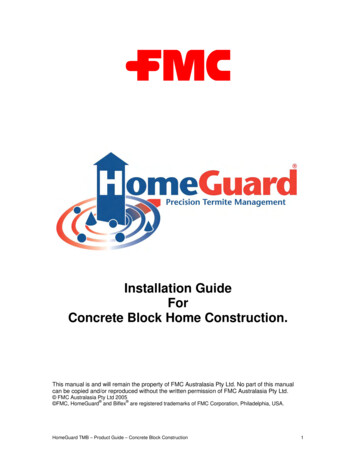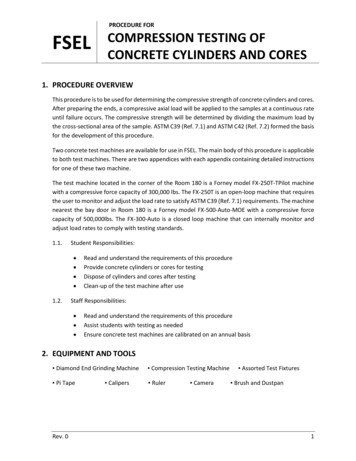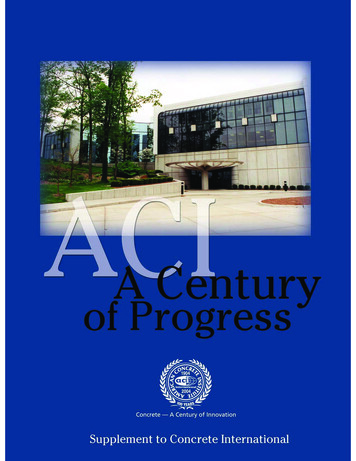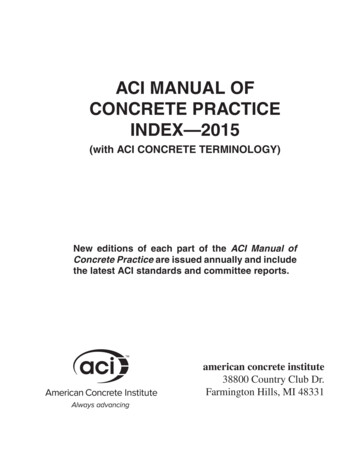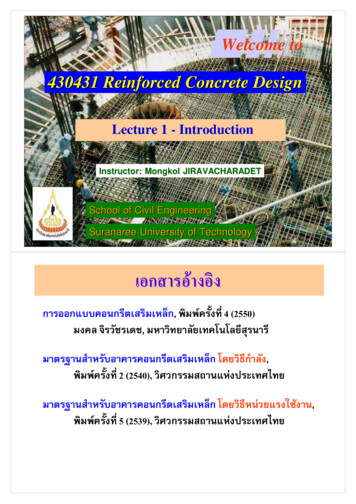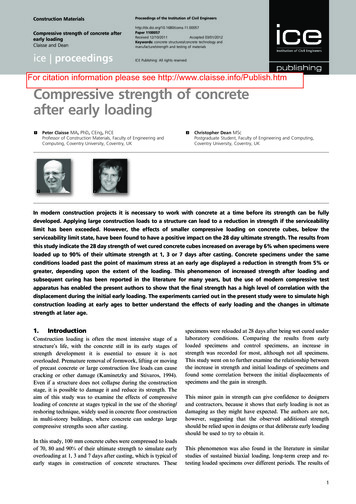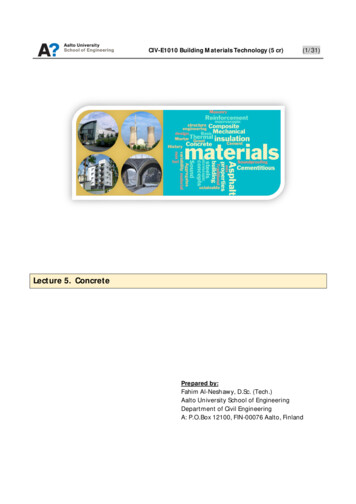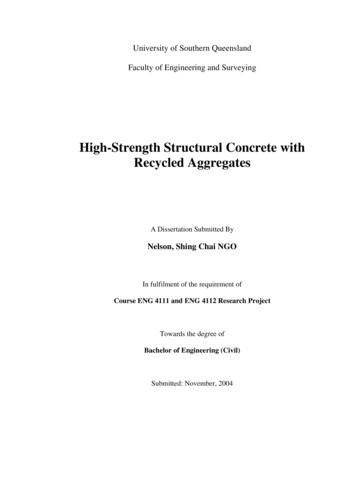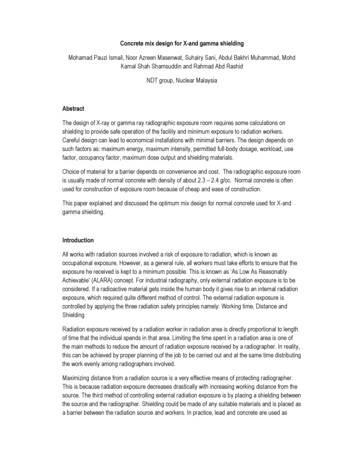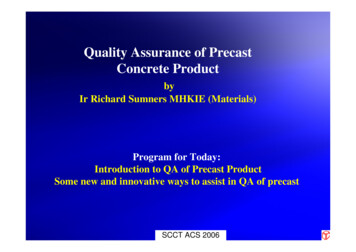
Transcription
Concrete BasicsContents1CONCRETE BASICS A Guide to Concrete PracticeCONTENTSpage 2ForewordCHAPTER 1Concrete Materialspages 3–5CHAPTER 2Concrete Propertiespages 6–9CHAPTER 3Concrete Testingpages 10–13CHAPTER 4Ordering Concretepage 14CHAPTER 5Proportioning and Mixing Concretepages 15–16CHAPTER 6Planning and Site Preparationpages 17–19CHAPTER 7Transporting and Placing Concretepages 20–22CHAPTER 8Compacting Concretepages 23–25CHAPTER 9Finishing Concretepages 26–27CHAPTER 10Curing Concretepages 28–30CHAPTER 11Joints in Concretepages 31–33CHAPTER 12Hot and Cold Weather Concretingpages 34–35CHAPTER 13Surface Finishes on Concretepages 36–39CHAPTER 14Defects in Concretepages 40–43CHAPTER 15Removing Stains from Concretepages 44–46CHAPTER 16Cracking in Concretepages 47–49CHAPTER 17Reinforced Concretepages 50–52CHAPTER 18Formworkpages 53–54pages 55–56MORE InformationFirst Published July 1991Second Edition 1992Third Edition 1994Fourth Edition 1996Fifth Edition October 2002Sixth Edition August 2004Cement Concrete & Aggregates AustraliaCement Concrete & Aggregates Australia is a not for profit organisationsponsored by the cement concrete and aggregate industries in Australiato provide information on the many uses of cement and concrete. Thispublication is produced by CCAA for that purpose. Since the informationprovided is intended for general guidance only and in no way replaces theservices of professional consultants on particular projects, no legal liabilitycan be accepted by CCAA for its use.Cement Concrete & Aggregates Australia1
Concrete BasicsCONTENTSForeword2ForewordConcrete is widely used in domestic, commercial, recreational, rural andeducational construction.Communities around the world rely on concrete as a safe, strong and simplebuilding material. It is used in all types of construction; from domestic work tomulti-storey office blocks and shopping complexes.Despite the common usage of concrete, few people are aware of theconsiderations involved in designing strong, durable, high quality concrete.Concrete Basics aims to provide a clear, concise explanation of all aspects ofmaking quality concrete; from the Materials and Properties involved throughPlanning, Preparation, Finishing and Curing.Concrete Basics addresses the needs of unskilled and semi-skilled personsundertaking general concreting projects including home and handyman projects.Concrete Basics also assists owner builders in the supervision of construction.It aims to develop an understanding of highly technical terms through cleardefinition accompanied by simple illustrations. A general understanding of theseterms will help to facilitate communication within the building industry.Concrete Basics will help to generate a higher standard of workmanship on-siteand facilitate better communication among construction workers, builders,engineers, building surveyors, architects and anyone interested in understandingthe processes involved in making quality concrete.Cement Concrete & Aggregates Australia2
Concrete BasicsConcrete Materials3CONTENTSCHAPTER 1 Concrete MaterialsCONCRETE is made by mixing:CEMENTWATERCOARSE AND FINE AGGREGATESADMIXTURES (if required).The aim is to mix these materials in measuredamounts to make concrete that is easy to:TRANSPORTPLACECOMPACTFINISHand which will set, and harden, to give a strongand durable product.The amount of each material (ie cement, water andaggregates) affects the properties of hardened concrete.(See CHAPTER 2 Concrete Properties)WATERCEMENTCEMENT The cement powder, when mixed with water,forms a paste.This paste acts like glue and holds or bonds theaggregates together.AGGREGATES65–80% of mix volumeThere are six majortypes of cement soldin Australia:Type GP (General Purpose Portland cement)Type GB (General Purpose Blended Cement)Type HE (High Early Strength cement)Type LH (Low Heat cement)Type SR (Sulfate Resisting cement)Type SL (Shrinkage Limited cement)Each type of cement will produce concrete with different properties.The most common types of cement are Type GP and Type GB.Blended cements contain portland cement and more than 5% ofeither fly ash, ground slag, silica fume, or a combination of these.Cement Concrete & Aggregates Australia3
Concrete BasicsConcrete Materials4CONTENTSSTORAGE Cement should be stored off the ground in awell-aired, clean, dry place.Wrapping the cement bags in plastic sheets gives extraprotection,Bulk cement will normally be stored in silos.AGGREGATES Aggregates are of two basic types:COARSE: crushed rock, gravel or screenings.FINE: fine and coarse sands and crusher fines.Sand should be concreting sand and not brickies sand or plasterers sand.Aggregates should be:STRONG and HARD A stronger, harder aggregate will give a stronger finalconcrete. Never use a crumble or flakey rock like sandstone.DURABLE to stand up to wear and tear and weathering.CHEMICALLY INACTIVE so the aggregatesdon’t react with the cement.CLEAN Dirt or clay sticking to the aggregateswill weaken the bond between paste and aggregates.GRADED Aggregates should range in size so that they fit together well.This gives a stronger and denser concrete.Rounded aggregates give a moreworkable mix. Angular aggregatesmake concrete harder to place, work and compact,but can make concrete stronger.STORAGE Aggregates should be stored where they will stay clean, separated from othermaterials and dry. If the aggregates are very wet use less water in the mix.WATER Water is mixed with the cement powder to form a paste whichholds the aggregates together like glue.Water must be clean, fresh and free from any dirt, unwanted chemicals orrubbish that may affect concrete.Many concrete plants now use recycled water.Cement Concrete & Aggregates Australia4
Concrete BasicsConcrete Materials5CONTENTSAlways check bore water before use.Don’t use sea water as it may rust the steelreinforcement in the concrete.ADMIXTURES Admixtures are mixed into the concrete to change or alter its properties, iethe time concrete takes to set and harden, or its workability.HOW THE PROCESS WORKS Measured amounts of the coarse and fine aggregates aremixed together.A measured amount of cement is added and mixed in.Enough water is added to make the mix workable. All the materials are then mixedtogether well. The cement powder and water form a paste which bonds the aggregatestogether like glue.Cement Concrete & Aggregates Australia5
Concrete BasicsConcrete Properties6CONTENTSCHAPTER 2 Concrete PropertiesThe Properties of Concrete are its characteristics or basic qualities.The four main properties of concrete are:WORKABILITYCOHESIVENESSSTRENGTH andDURABILITYConcrete has three different states:PLASTICSETTINGHARDENINGIn each state it has different properties.CONCRETE STATESPlastic State When the concrete is first mixed it is like 'bread dough'.It is soft and can be worked or moulded into different shapes. In thisstate concrete is called PLASTIC. Concrete is plastic during placingand compaction.The most important properties of plastic concrete are workabilityand cohesiveness.A worker will sink into plastic concrete.Setting State Concrete then begins to stiffen. The stiffeningof concrete, when it is no longer soft, is called SETTING.Setting takes place after compaction and during finishing.Concrete that is sloppy or wet may be easy to place but willbe more difficult to finish.A worker leaves footprints in setting concrete.Hardening State After concrete has set it begins togain strength and harden. The properties of hardenedconcrete are strength and durability.Hardened concrete will have no footprints on it if walked on.Cement Concrete & Aggregates Australia6
Concrete BasicsConcrete PropertiesCONTENTS7Workability Workability means how easy it is to:PLACEHANDLECOMPACT andFINISH a concrete mix.Concrete that is stiff or dry may be difficult to Handle, Place, Compact, and Finish and, ifnot constructed properly, will not be as strong or durable when finally hardened. A slumptest can be used to measure the workability of concrete.See CHAPTER 3 Concrete TestingWorkability is affected by:THE AMOUNT OF CEMENT PASTEThe cement paste is the soft or liquid part of the concrete mix. The more pastemixed with the coarse and fine aggregates, the more workable a mix.THE AGGREGATE GRADINGSee Aggregate Grading under Cohesiveness.Well-graded, smooth, rounded aggregates improve the workability of a mix.To make a more workable mix:Add more CEMENT PASTE.Use WELL GRADED aggregates.Use an ADMIXTURE.Never try to make a mixture more workable by justadding more water because this lowers the strengthand durability of concrete.Cement Concrete & Aggregates Australia7
Concrete BasicsConcrete Properties8CONTENTSStrength and Durability Well made concrete is a naturally strong and durable material.It is DENSE, reasonably WATERTIGHT, able to resist changes in TEMPERATURE, as wellas wear and tear from WEATHERING.Strength and Durability are affected by the density of the concrete. Denser concrete ismore watertight (or less permeable).Concrete durability INCREASES with strength.Well made concrete is very important to protect the steel in reinforced concrete.See CHAPTER 17 Reinforced ConcreteStrength of concrete in the hardened state is usuallymeasured by the COMPRESSIVE STRENGTHusing the Compression Test.See CHAPTER 3 Concrete TestingStrength and Durability are affected by:COMPACTION Compaction is removing the air from concrete. Proper compactionresults in concrete with an increased density which is stronger and more durable.See CHAPTER 8 Compacting ConcreteCURING Curing is keeping concrete damp for a period, to allow it to reach maximumstrength. Longer curing will give more durable concrete.See CHAPTER 10 Curing ConcreteWEATHER Warmer weather will cause concrete to have a higher early strength.See CHAPTER 12 Hot and Cold Weather ConcretingTYPE OF CEMENT Different types of cement will affect concrete properties: ie howquickly or slowly concrete gains strength.THE WATER TO CEMENT RATIO Too much water and not enough cement meansconcrete will be weaker and less durable.The water to cement ratio (W/C) isthe weight of the water divided bythe weight of cement.WaterW/C 20 litresieCement 0.540 kgNote: 1 litre of water weighs 1 kilogram.The lower the ratio, the strongerthe concrete.Cement Concrete & Aggregates Australia8
Concrete BasicsConcrete PropertiesCONTENTS9CohesivenessCohesiveness is how well concrete HOLDS TOGETHER when plastic.Cohesiveness is affected by:THE AGGREGATE GRADINGGraded Aggregate means that there is a range of size of aggregates, from largerocks to small sands. Well-graded aggregates give a more cohesive mix, too muchcoarse aggregate gives a boney mix.WATER CONTENTA mix that has too much water will not be cohesive and may separate and bleed.Cement Concrete & Aggregates Australia9
Concrete BasicsConcrete TestingCONTENTS10CHAPTER 3 Concrete TestingThere are two main tests to be done on concrete:The SLUMP test.The SLUMP test shows the WORKABILITY of concrete.Workability measures how easy the concrete is to place, handleand compact.See CHAPTER 2 Concrete PropertiesThe COMPRESSION test.The COMPRESSION test shows the best possible strengthconcrete can reach in perfect conditions.The compression test measures concrete strength in thehardened state.Testing should always be done carefully. Wrong test results can be costly.SAMPLING The first step is to take a test sample from the large batch of concrete. Thisshould be done as soon as discharge of the concrete commences. The sample should berepresentative of the concrete supplied.The sample is taken in one of two ways:For purposes of accepting or rejecting the load: Sampling after 0.2 m3 of the load hasbeen poured.For routine quality checks: Sampling from three places in the load.Cement Concrete & Aggregates Australia10
Concrete BasicsConcrete Testing11CONTENTSTHE SLUMP TEST The slump test is done to make sure a concrete mix is workable.The measured slump must be within a set range, or tolerance, from the target slump.ToolsStandard slump cone (100 mm top diameter x 200 mm bottom diameter x 300 mm high)Small scoopBullet-nosed rod(600 mm long x 16 mm diameter)RuleSlump plate (500 mm x 500 mm)Method1 Clean the cone. Dampen with water and place on the slump plate.The slump plate should be clean, firm, level and non-absorbent.2 Collect a sample. See Sampling3 Stand firmly on the footpieces and fill 1/3 the volume of the cone withthe sample. Compact the concrete by 'rodding' 25 times.Rodding Rodding means to push a steel rod in and out of theconcrete to compact it into the cylinder, or slump cone.Always rod in a definite pattern, working from outside into the middle.4 Now fill to 2 /3 and again rod 25 times, just into the topof the first layer.5 Fill to overflowing, rodding again this time just into the topof the second layer. Top up the cone till it overflows.6 Level off the surface with the steel rod using a rollingaction. Clean any concrete from aroundthe base and top of the cone, push down on thehandles and step off the footpieces.7 Carefully lift the cone straight up making surenot to move the sample.8 Turn the cone upside down and place the rod across theup-turned cone.The Slump Test continues on the next pageCement Concrete & Aggregates Australia11
Concrete BasicsConcrete Testing12CONTENTS9 Take several measurements and report the averagedistance to the top of the sample.10 If the sample fails by being outside thetolerance (ie the slump is too high or too low),another must be taken. If this also fails theremainder of the batch should be rejected.THE COMPRESSION TEST The compression test shows the compressive strength ofhardened concrete. The testing is done in a laboratory off-site. The only work done on-siteis to make a concrete cylinder for the compression test.The strength is measured in Megapascals (MPa) and is commonly specified as acharacteristic strength of concrete measured at 28 days after mixing. The compressivestrength is a measure
CHAPTER 12 Hot and Cold Weather Concreting pages 34–35 CHAPTER 13 Surface Finishes on Concrete pages 36–39 CHAPTER 14 Defects in Concrete pages 40–43 CHAPTER 15 Removing Stains from Concrete pages 44–46 CHAPTER 16 Cracking in Concrete pages 47–49 CHAPTER 17 Reinforced Concrete pages 50–52 CHAPTER 18 Formwork pages 53–54 MORE Information pages 55–56
